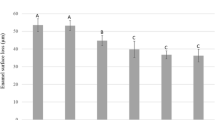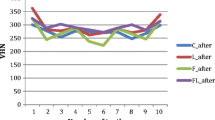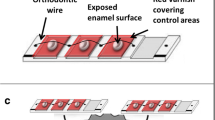Abstract
The aim of this in vitro study was to evaluate the protective effect of short-pulsed CO2 9.3 μm laser irradiation against erosion in human enamel without and combined with TiF4 and AmF/NaF/SnCl2 applications, respectively, as well as compared to the protective effect of these fluoride treatments alone. After polishing, ninety enamel samples (3 × 3mm) were used for 9 different treatment groups: 4% TiF4 gel (pH 1.5, 24,533 ppm F−); AmF/NaF/SnCl2 rinse (pH 4.5; 500 ppm F−, 800 ppm Sn2); CO2 laser (average power 0.58 W); CO2 laser (0.58 W) + TiF4; CO2 laser (0.58 W) + AmF/NaF/SnCl2; CO2 laser (0.69 W); CO2 laser (0.69 W) + TiF4; CO2 laser (0.69 W) + AmF/NaF/SnCl2; negative control (deionized water). TiF4 gel was brushed on only once before the first erosive cycling, while samples treated with AmF/NaF/SnCl2 were daily immersed in 5 ml of the solution before cycling. Laser treatment occurred with a CO2 laser (wavelength 9.3 μm, pulse repetition rate 100 Hz, pulse duration 14.6 μs/18 μs, average power 0.58 W/0.69 W, fluence 1.9 J/cm2/2.2 J/cm2, beam diameter 0.63 mm, irradiation time 10 s, air cooling). TiF4 was applied only once, while AmF/NaF/SnCl2 was applied once daily before the erosive challenge. Surface loss (in μm) was measured with optical profilometry immediately after treatment, and after 5 and 10 days of erosive cycling (0.5% citric acid, pH 2.3, 6 × 2 min/day). Additionally, scanning electron microscopy investigations were performed. All application measures resulted in loss of surface height immediately after treatment. After 5 days, significantly reduced surface loss was observed after applying laser irradiation (both power settings) followed by applications of TiF4 or AmF/NaF/SnCl2 solution (p < 0.05; 2-way ANOVA and Tukey test) compared to fluoride application alone. After 10 days, compared to after 5 days, a reduced tissue loss was observed in all groups treated with AmF/NaF/SnCl2 solution. This tissue gain occurred with the AmF/NaF/SnCl2 application alone and was significantly higher when the application was combined with the laser use (p < 0.05). Short-pulsed CO2 9.3 μm laser irradiation followed by additional application of AmF/NaF/SnCl2 solution significantly reduces the progression of dental enamel erosion in vitro.


Similar content being viewed by others
References
Ganss C, Klimek J, Brune V, Schurmann A (2004) Effects of two fluoridation measures on erosion progression in human enamel and dentine in situ. Caries Res 38(6):561–566
Vieira A, Ruben JL, Huysmans MC (2005) Effect of titanium tetrafluoride, amine fluoride and fluoride varnish on enamel erosion in vitro. Caries Res 39(5):371–379
Ganss C, Lussi A, Sommer N, Klimek J, Schlueter N (2010) Efficacy of fluoride compounds and stannous chloride as erosion inhibitors in dentine. Caries Res 44(3):248–252
Levy FM, Magalhaes AC, Gomes MF, Comar LP, Rios D, Buzalaf MA (2012) The erosion and abrasion-inhibiting effect of TiF(4) and NaF varnishes and solutions on enamel in vitro. Int J Paediatr Dent 22(1):11–16
Wasser G, Joao-Souza SH, Lussi A, Carvalho TS (2018) Erosion-protecting effect of oral-care products available on the Swiss market. A pilot study. Swiss Dent J 128(4):290–296
Ganss C, Schlueter N, Hardt M, Schattenberg P, Klimek J (2008) Effect of fluoride compounds on enamel erosion in vitro: a comparison of amine, sodium and stannous fluoride. Caries Res 42(1):2–7
Lussi A, Buzalaf MAR, Duangthip D, Anttonen V, Ganss C, Joao-Souza SH et al (2019) The use of fluoride for the prevention of dental erosion and erosive tooth wear in children and adolescents. Eur Arch Paediatr Dent
Skartveit L, Gjerdet NR, Selvig KA (1991) Release of fluoride and metal ions from root surfaces after topical application of TiF4, SnF2, and NaF in vitro. Acta Odontol Scand 49(3):127–131
Wiegand A, Waldheim E, Sener B, Magalhaes AC, Attin T (2009) Comparison of the effects of TiF4 and NaF solutions at pH 1.2 and 3.5 on enamel erosion in vitro. Caries Res 43(4):269–277
Lussi A, Carvalho TS (2015) The future of fluorides and other protective agents in erosion prevention. Caries Res 49(Suppl 1):18–29
Babcock FD, King JC, Jordan TH (1978) The reaction of stannous fluoride and hydroxyapatite. J Dent Res 57(9–10):933–938
Featherstone JD, Barrett-Vespone NA, Fried D, Kantorowitz Z, Seka W (1998) CO2 laser inhibitor of artificial caries-like lesion progression in dental enamel. J Dent Res 77(6):1397–1403
Kantorowitz Z, Featherstone JD, Fried D (1998) Caries prevention by CO2 laser treatment: dependency on the number of pulses used. J Am Dent Assoc 129(5):585–591
Rodrigues LK, Nobre dos Santos M, Pereira D, Assaf AV, Pardi V (2004) Carbon dioxide laser in dental caries prevention. J Dent 32(7):531–540
Esteves-Oliveira M, Apel C, Gutknecht N, Velloso WF, Cotrim MEB, Eduardo CP et al (2008) Low-fluence CO2 laser irradiation decreases enamel solubility. Laser Phys 18(4):478–485
Rechmann P, Charland DA, Rechmann BM, Le CQ, Featherstone JD (2013) In-vivo occlusal caries prevention by pulsed CO2-laser and fluoride varnish treatment—a clinical pilot study. Lasers Surg Med 45(5):302–310
Rechmann P, Fried D, Le CQ, Nelson G, Rapozo-Hilo M, Rechmann BM et al (2011) Caries inhibition in vital teeth using 9.6-μm CO2-laser irradiation. J Biomed Opt 16(7):071405
Fried D, Glena RE, Featherstone JD, Seka W (1997) Permanent and transient changes in the reflectance of CO2 laser-irradiated dental hard tissues at lambda = 9.3, 9.6, 10.3, and 10.6 microns and at fluences of 1-20 J/cm2. Lasers Surg Med 20(1):22–31
Nelson DG, Wefel JS, Jongebloed WL, Featherstone JD (1987) Morphology, histology and crystallography of human dental enamel treated with pulsed low-energy infrared laser radiation. Caries Res 21(5):411–426
Goodis HE, Fried D, Gansky S, Rechmann P, Featherstone JD (2004) Pulpal safety of 9.6 microm TEA CO2 laser used for caries prevention. Lasers Surg Med 35(2):104–110
Featherstone JD, Nelson DG (1987) Laser effects on dental hard tissues. Adv Dent Res 1(1):21–26
Zuerlein MJ, Fried D, Featherstone JD (1999) Modeling the modification depth of carbon dioxide laser-treated dental enamel. Lasers Surg Med 25(4):335–347
Fried D, Zuerlein MJ, Le CQ, Featherstone JD (2002) Thermal and chemical modification of dentin by 9-11-microm CO2 laser pulses of 5-100-micros duration. Lasers Surg Med 31(4):275–282
Tepper SA, Zehnder M, Pajarola GF, Schmidlin PR (2004) Increased fluoride uptake and acid resistance by CO2 laser-irradiation through topically applied fluoride on human enamel in vitro. J Dent 32(8):635–641
Rodrigues LK, Nobre Dos Santos M, Featherstone JD (2006) In situ mineral loss inhibition by CO2 laser and fluoride. J Dent Res 85(7):617–621
Chin-Ying SH, Xiaoli G, Jisheng P, Wefel JS (2004) Effects of CO2 laser on fluoride uptake in enamel. J Dent 32(2):161–167
Wiegand A, Magalhaes AC, Navarro RS, Schmidlin PR, Rios D, Buzalaf MA et al (2010) Effect of titanium tetrafluoride and amine fluoride treatment combined with carbon dioxide laser irradiation on enamel and dentin erosion. Photomed Laser Surg 28(2):219–226
Lepri TP, Colucci V, Turssi CP, Corona SA (2013) Permeability of eroded enamel following application of different fluoride gels and CO2 laser. Lasers Med Sci 28(1):235–240. https://doi.org/10.1007/s10103-012-1123-2
Lepri TP, Colucci V, Turssi CP, Corona SA (2015) In situ investigation of the effect of TiF4 and CO2 laser irradiation on the permeability of eroded enamel. Arch Oral Biol 60(6):941–947
Rechmann P, Le CQ, Kinsel R, Kerbage C, Rechmann BMT (2020) In vitro CO2 9.3 μm short-pulsed laser caries prevention—effects of a newly developed laser irradiation pattern. Lasers Med Sci. https://doi.org/10.1007/s10103-019-02940-z
Schlueter N, Lussi A, Tolle A, Ganss C (2016) Effects of erosion protocol design on erosion/abrasion study outcome and on active agent (NaF and SnF2) efficacy. Caries Res 50(2):170–179
Gerrard WA, Winter PJ (1986) Evaluation of toothpastes by their ability to assist rehardening of enamel in vitro. Caries Res 20(3):209–216
Hara AT, Lippert F, Zero DT (2013) Interplay between experimental dental pellicles and stannous-containing toothpaste on dental erosion-abrasion. Caries Res 47(4):325–329
Jaeggi T, Lussi A (2014) Prevalence, incidence and distribution of erosion. Monogr Oral Sci 25:55–73
Schlueter N, Ganss C, Mueller U, Klimek J (2007) Effect of titanium tetrafluoride and sodium fluoride on erosion progression in enamel and dentine in vitro. Caries Res 41(2):141–145
Schlueter N, Klimek J, Ganss C (2009) Effect of stannous and fluoride concentration in a mouth rinse on erosive tissue loss in enamel in vitro. Arch Oral Biol 54(5):432–436
Yu H, Attin T, Wiegand A, Buchalla W (2010) Effects of various fluoride solutions on enamel erosion in vitro. Caries Res 44(4):390–401
da Silva CV, Ramos-Oliveira TM, Mantilla TF, de Freitas PM (2017) Frequency of application of AmF/NaF/SnCl2 solution and its potential in controlling human enamel erosion progression: an in situ study. Caries Res 51(2):141–148
Tveit AB, Klinge B, Totdal B, Selvig KA (1988) Long-term retention of TiF4 and SnF2 after topical application to dentin in dogs. Scand J Dent Res 96(6):536–540
Mundorff SA, Little MF, Bibby BG (1972) Enamel dissolution. II. Action of titanium tetrafluoride. J Dent Res 51(6):1567–1571
Wiegand A, Magalhaes AC, Attin T (2010) Is titanium tetrafluoride (TiF4) effective to prevent carious and erosive lesions? A review of the literature. Oral Health Prev Dent 8(2):159–164
Comar LP, Cardoso Cde A, Charone S, Grizzo LT, Buzalaf MA, Magalhaes AC (2015) TiF4 and NaF varnishes as anti-erosive agents on enamel and dentin erosion progression in vitro. J Appl Oral Sci 23(1):14–18
Magalhaes AC, Dos Santos MG, Comar LP, Buzalaf MA, Ganss C, Schlueter N (2016) Effect of a single application of TiF4 varnish versus daily use of a low-concentrated TiF4/NaF solution on tooth erosion prevention in vitro. Caries Res 50(5):462–470
Magalhaes AC, Comar LP, Rios D, Delbem AC, Buzalaf MA (2008) Effect of a 4% titanium tetrafluoride (TiF4) varnish on demineralisation and remineralisation of bovine enamel in vitro. J Dent 36(2):158–162
Magalhaes AC, Rios D, Honorio HM, Jorge AM Jr, Delbem AC, Buzalaf MA (2008) Effect of 4% titanium tetrafluoride solution on dental erosion by a soft drink: an in situ/ex vivo study. Arch Oral Biol 53(5):399–404
Schlueter N, Klimek J, Ganss C (2009) Efficacy of an experimental tin-F-containing solution in erosive tissue loss in enamel and dentine in situ. Caries Res 43(6):415–421
Yu H, Wegehaupt FJ, Zaruba M, Becker K, Roos M, Attin T et al (2010) Erosion-inhibiting potential of a stannous chloride-containing fluoride solution under acid flow conditions in vitro. Arch Oral Biol 55(9):702–705
Schlueter N, Klimek J, Ganss C (2011) Efficacy of tin-containing solutions on erosive mineral loss in enamel and dentine in situ. Clin Oral Investig 15(3):361–367
West NX, Hellin N, Eusebio R, He T (2019) The erosion protection efficacy of a stabilized stannous fluoride dentifrice: an in situ randomized clinical trial. Am J Dent 32(3):138–142
West NX, He T, Hellin N, Claydon N, Seong J, Macdonald E et al (2019) Randomized in situ clinical trial evaluating erosion protection efficacy of a 0.454% stannous fluoride dentifrice. Int J Dent Hyg 17(3):261–267
Zhao X, He T, He Y, Cheng C, Chen H. A randomized clinical trial to measure the erosion protection benefits of a novel stabilized stannous fluoride dentifrice versus a control dentifrice. J Clin Dent. 2017;28(4 Spec No B):B17–20
Hove L, Holme B, Ogaard B, Willumsen T, Tveit AB (2006) The protective effect of TiF4, SnF2 and NaF on erosion of enamel by hydrochloric acid in vitro measured by white light interferometry. Caries Res 40(5):440–443
Rechmann P, Rechmann BM, Groves WH Jr, Le CQ, Rapozo-Hilo ML, Kinsel R et al (2016) Caries inhibition with a CO2 9.3 μm laser: an in vitro study. Lasers Surg Med 48(5):546–554
Featherstone JD, Nelson DG (1989) Recent uses of electron microscopy in the study of physico-chemical processes affecting the reactivity of synthetic and biological apatites. Scanning Microsc 3(3):815–827 discussion 27-8
Fowler BO, Kuroda S (1986) Changes in heated and in laser-irradiated human tooth enamel and their probable effects on solubility. Calcif Tissue Int 38:197–208
Legeros RZ (1991) Calcium phosphates in enamel, dentin and bone. In: Myers HM (ed) Calcium phosphates in oral biology and medicine. Karger, Basel, pp 108–129
Takagi S, Liao H, Chow LC (2000) Effect of tooth-bound fluoride on enamel demineralization/remineralization in vitro. Caries Res 34(4):281–288
Kim JW, Lee R, Chan KH, Jew JM, Fried D (2017) Influence of a pulsed CO2 laser operating at 9.4 mum on the surface morphology, reflectivity, and acid resistance of dental enamel below the threshold for melting. J Biomed Opt 22(2):28001
Ramalho KM, Eduardo CP, Heussen N, Rocha RG, Meyer-Lueckel H, Lampert F et al (2019) Randomized in situ study on the efficacy of CO2 laser irradiation in increasing enamel erosion resistance. Clin Oral Investig 23(5):2103–2112
Esteves-Oliveira M, Witulski N, Hilgers RD, Apel C, Meyer-Lueckel H, Eduardo CP (2015) Combined tin-containing fluoride solution and CO2 laser treatment reduces enamel erosion in vitro. Caries Res 49(6):565–574
Phan ND, Fried D, Featherstone JDB. Laser-induced transformation of carbonated apatite to fluorapatite on bovine enamel. BiOS '99 International Biomedical Optics Symposium. SPIE; 1999
Meurman JH, Hemmerle J, Voegel JC, Rauhamaa Makinen R, Luomanen M (1997) Transformation of hydroxyapatite to fluorapatite by irradiation with high-energy CO2 laser. Caries Res 31(5):397–400
Funding
This study was funded by Fundação de Amparo à Pesquisa do Estado de São Paulo – FAPESP (Grant no. 2015/10248-5 and 2016/08524-7).
Author information
Authors and Affiliations
Corresponding author
Ethics declarations
Conflict of interest
The authors declare that they have no conflict of interest.
Ethical approval
Teeth were collected for research purposes under Universidade de São Paulo (USP) Local Research Ethics Committee study approval.
Informed consent
NA
Additional information
Publisher’s note
Springer Nature remains neutral with regard to jurisdictional claims in published maps and institutional affiliations.
Rights and permissions
About this article
Cite this article
Silva, C.V., Mantilla, T.F., Engel, Y. et al. The effect of CO2 9.3 μm short-pulsed laser irradiation in enamel erosion reduction with and without fluoride applications—a randomized, controlled in vitro study. Lasers Med Sci 35, 1213–1222 (2020). https://doi.org/10.1007/s10103-020-02979-3
Received:
Accepted:
Published:
Issue Date:
DOI: https://doi.org/10.1007/s10103-020-02979-3




